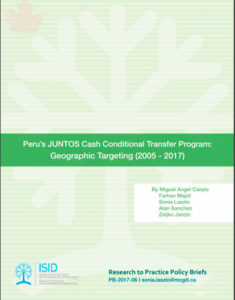Peru’s JUNTOS Cash Conditional Transfer Program: Geographic Targeting (2005-2017)
| Year | : | 2019 |
|---|---|---|
| Author/s | : | Miguel Ángel Carpio, Farhan Majid, Sonia Laszlo, Alan Sanchez, Zeljko Janzic |
| Area/s | : | Methodologies for research and evaluation of policy and programmes, Poverty and equality |
Carpio, Miguel Ángel; Farhan Majid, Sonia Laszlo, Alan Sánchez y Zeljko Janzic (2019). Peru’s JUNTOS cash conditional transfer program: Geographic Targeting (2005- 2017). ISID.
Conditional Cash Transfers (CCTs) have become an important anti-poverty policy globally in recent decades by aiming to alleviate poverty through financial incentives tied directly to human capital investments (namely primary and secondary schooling and maternal and child health). In Peru, the CCT program JUNTOS targeting poor families was established in 2005. By 2017, it has covered 693 thousand families in 1,305 of Peru’s 1,943 districts.
Official sources estimate that 72% of all potential household beneficiaries were already covered by the program by 2015. In order to select its beneficiaries, JUNTOS implemented a two-stage procedure. The first stage involves geographic targeting by selecting districts in need. The second stage then selects households in the targeted districts. In both cases the program follows an eligibility rule. Like most large-scale anti-poverty programs, JUNTOS was rolled out in several phases. However, despite considerable work evaluating JUNTOS, to our knowledge the various phases and changes observed in the eligibility rule over these phases have not yet been described in detail in one single public document. Furthermore, in discussions with researchers who have evaluated JUNTOS, some discrepancies have been noted between de jure criteria for selection and de facto receipt of benefits. With this in mind, this report has two objectives: (i) to document the information available about the eligibility rule at the district level (also known as the geographic rule); and (ii) to use the information available to replicate the eligibility rule using information that is publicly available.






